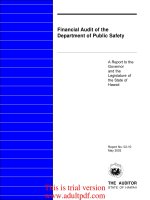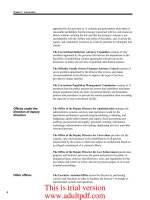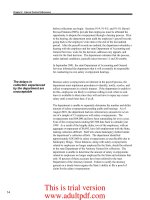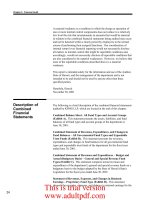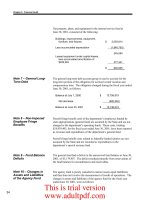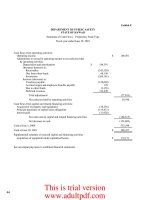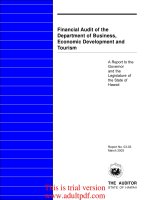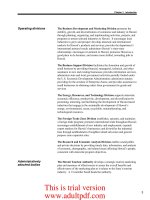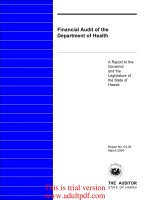Financial Audit of the Department of Public Safety A Report to the Governor and the Legislature of the State of Hawaii Report No. 02-10 May 2002_part2 docx
Bạn đang xem bản rút gọn của tài liệu. Xem và tải ngay bản đầy đủ của tài liệu tại đây (189.48 KB, 11 trang )
5
Chapter 1: Introduction
The Public Affairs Office advises and assists the director in the
management and conduct of a comprehensive program for effective
public relations by informing the public of departmental plans, activities,
and accomplishments, and providing reliable and timely responses to the
media or other public inquiries regarding matters of special interest;
advises departmental staff on public affairs policies and procedures; and
manages the preparation and distribution of the departmental annual
report.
The Internal Affairs Office conducts criminal, administrative, and civil
investigations of the employees of the department and the lawful use and
disposition of departmental resources.
The Inspections and Investigations Office administers the proper
execution of laws, rules, regulations, standards, and directives set forth
for the operations of the department.
The Civil Rights Compliance Office advises departmental
management, supervisors, and employees on compliance with civil rights
and related laws, and develops, updates, and oversees implementation of
the departmental affirmative action plan.
1. To assess the adequacy, effectiveness, and efficiency of the systems
and procedures for the financial accounting, internal control, and
financial reporting of the department; to recommend improvements
to such systems, procedures, and reports; and to report on the
financial statements of the department.
2. To ascertain whether expenses or deductions and other
disbursements have been made and all revenues or additions and
other receipts have been collected and accounted for in accordance
with federal and state laws, rules and regulations, and policies and
procedures.
3. To make recommendations as appropriate.
We audited the financial records and transactions and reviewed the
related systems of accounting and internal controls of the department for
the fiscal year July 1, 2000 to June 30, 2001. We tested financial data to
provide a basis to report on the fairness of the presentation of the
financial statements. We also reviewed the department’s transactions,
systems, and procedures for compliance with applicable laws,
regulations, and contracts.
Objectives of the
Audit
Scope and
Methodology
This is trial version
www.adultpdf.com
6
Chapter 1: Introduction
We examined the existing accounting, reporting, and internal control
structure and identified deficiencies and weaknesses therein. We made
recommendations for appropriate improvements including, but not
limited to, the forms and records, the management information system,
and the accounting and operating procedures.
The independent auditors’ opinion as to the fairness of the department’s
financial statements presented in Chapter 3 is that of KPMG LLP. The
audit was conducted from July 2001 through November 2001 in
accordance with generally accepted government auditing standards.
This is trial version
www.adultpdf.com
7
Chapter 2: Internal Control Deficiencies
Chapter 2
Internal Control Deficiencies
Internal controls are steps instituted by management to ensure that
objectives are met and resources are safeguarded. This chapter presents
our findings and recommendations on the financial accounting and
internal control practices and procedures of the Department of Public
Safety (department).
We found several reportable conditions involving the department’s
internal control over financial reporting and operations. Reportable
conditions are significant deficiencies in the design or operation of the
internal control over financial reporting that, in our judgment, could
adversely affect the department’s ability to record, process, summarize,
and report financial data consistent with the assertions of management in
the financial statements. Similar issues were communicated to the
department in our Report No. 00-05, Management and Financial Audit
of the Department of Public Safety.
We found the following reportable conditions:
1. Overtime costs are significant and unusual patterns of sick leave
usage continue.
2. Collecting staff salary overpayments in a timely manner continues to
be a problem for the department.
3. The department is not fulfilling its fiduciary responsibilities to the
inmates and the victims and families of inmates.
4. The department is unable to provide sufficient documentation to
support $134 million of fixed assets reported in the department’s
financial statements. In addition, fixed assets reported in the internal
service fund (correctional industries programs) do not reconcile to
the Annual Inventory Report of Property.
Prior audits performed by our office highlighted the department’s failure
to control overtime costs and patterns of sick leave abuse among
department employees, specifically the adult correctional officers (ACO)
and medical and food service staff. Salaries and wages are the most
significant facility expenditure, comprising 85 percent of total facility
expenditures or approximately $52.9 million for the fiscal year ended
Summary of
Findings
Significant
Overtime and
Unusual Sick
Leave Usage
Continue
This is trial version
www.adultpdf.com
8
Chapter 2: Internal Control Deficiencies
June 30, 2001. Of these expenditures, overtime wages comprise $7
million. Between the fiscal years ended June 30, 1999 and 2000,
overtime cost decreased from $9.8 million to $7.6 million. Overtime at
approximately 13 percent of total salaries and wages is still a significant
departmental expense. Under these circumstances, the department
should be especially vigilant in its efforts to minimize overtime and
prevent sick leave abuse. However, despite the department’s efforts to
monitor overtime and sick leave, it continues to incur significant
overtime costs and experience unusual patterns of sick leave.
We reviewed a sample of 22 ACOs and three food service staff who had
unusual levels of sick leave usage. Our review of overtime costs
identified vacation or sick leave as the documented reason for the vacant
positions and the resulting overtime.
Overtime for ACOs normally occurs when an ACO who is not scheduled
to work is called in to replace a vacant security post. In most cases, the
facility watch commander determines whether an ACO should be called
in to work overtime. This decision is based on staffing of the facilities’
posts. Each facility has both essential and program posts. Essential
posts are the minimum posts required to secure, house, clothe, and feed
the inmates, and provide safety for the employees, inmates, and public.
All essential posts must be staffed. If an essential post must be filled, the
watch commander first determines whether any program posts can be
closed and whether the ACO staffed at that post can be transferred to the
essential post. Program posts are considered non-essential and exist to
run programs, such as recreation, education, volunteer programs, and
activities. We were informed that there is no set criteria for determining
which program posts can be closed. If a program post is or becomes
vacant, an ACO would not be called in on overtime to fill the vacancy.
The facility chief of security reviews the decisions to close program
posts and incur overtime, after completion of the shift. The lack of
standard criteria for evaluating open posts and the untimely review of
decisions to incur overtime continues to leave the department susceptible
to overtime abuse.
Vacant ACO positions also contribute to overtime costs. During fiscal
year ended June 30, 2001, there were approximately 90 ACO positions
vacant, a decrease of nearly 50 vacancies from the fiscal year ended June
30, 2000.
Medical and food service staff also incur unusual levels of overtime and
high sick leave usage. Specifically, we found that for the two food
service staff and the two medical staff included in our overtime sample,
over 40 percent of their total compensation related to overtime. In
addition, all three food service staff included in our sick leave sample
Overtime is driven by
sick leave and staff
vacancies
This is trial version
www.adultpdf.com
9
Chapter 2: Internal Control Deficiencies
stook more than the allotted 21 days of sick leave per year, averaging
approximately 330 hours or 41 days of sick leave taken per employee.
Unusual patterns of sick leave continue despite the
department’s sick leave abuse program
The department’s existing sick leave abuse programs is ineffective
against the misuse of sick leave. The collective bargaining agreement
with the ACOs and medical and food service staff allows the department
to investigate unusual patterns of sick leave. Patterns indicative of abuse
occur over a six-month period, with six or more occurrences each of at
least one of the following: sick leave of short durations or occurring
before or after holidays, weekends, days off, paydays, or specific days of
the week. Such unusual patterns are identified by the wardens at each
facility through a manual review and analysis of employee sick leave
records. When a pattern is detected, the employee is placed in a six-
month follow up evaluation program. Once in the program, the
department can require the employee to undergo medical evaluations by
a doctor specified by the department to verify all absences due to
sickness.
Despite the program, we found that unusual sick leave patterns continue
to occur within the department. Our sample of 25 ACOs and food
service staff who had unusual levels of sick leave usage revealed the
following:
• All employees took more than the allotted 21 days of sick leave
per year, averaging approximately 290 hours or 36 days of sick
leave taken per employee.
• Nine employees (36 percent) had 20 hours or less of sick leave
accrued on June 30, 2001, and two employees had sick leave
balances of zero. One of the employees with a sick leave
balance of zero was hired in 1983, which means that this
employee used all of his allotted sick leave accumulated since
1983.
• Six employees (24 percent) had 51 instances in which they
worked overtime within three days before or after taking sick or
vacation leave.
• Nine employees (36 percent) had a total of six or more
occurrences of different sick leave abuse indicators for the six-
month review period, but were not investigated because the
department’s policy defines a pattern of sick leave abuse as six
or more occurrences of the same type of abuse indicator within a
six-month period.
This is trial version
www.adultpdf.com
10
Chapter 2: Internal Control Deficiencies
• One of the two employees placed in the sick leave abuse
program should have begun the program on June 16, 2001, but
was not immediately notified and was consequently not placed in
the program until July 4, 2001. Again, the employee took sick
leave during this period; however, his program was not extended
for the approximate half-month delay.
The high levels of sick leave usage are not confined to these individuals.
An average of 27 sick leave days was taken during the fiscal year ended
June 30, 2001 for all uniformed staff, which includes ACOs and medical
and food service staff. This amount is significantly higher than (1) the
average of ten days for all state employees, based on the estimate used by
the actuary for the Employees’ Retirement System of the State of
Hawaii; (2) the national average
1
of nine days for all protective services,
which includes police officers and prison and security guards; and (3) the
national average
1
of 12 days for all government employees.
Average sick leave days per employee increased significantly between
the three quarters ended June 30, 2001 and June 30, 2000 at the Waiawa
Correctional Facility (29 percent increase) and the Women’s Community
Correctional Center (28 percent increase). We were informed that at the
Waiawa Correctional Facility, it appeared that sick leave was used when
employees were denied vacation leave. At the Women’s Community
Correctional Center, we were informed that employees used sick leave
time to care for their children during breaks from school. We were
informed that both situations were not investigated because no clear
evidence existed and because the department did not want to jeopardize
employee morale. However, the department has a fiduciary duty to
taxpayers to ensure that sick leave usage is in accordance with state
statutes. Any apparent abuse of sick leave should be investigated in a
timely manner.
The continued unusual sick leave patterns and the high levels of sick
leave usage raise doubts about the effectiveness of the department’s sick
leave abuse program.
High sick leave usage results in significant overtime costs to the
department
During the fiscal year ended June 30, 2001, the facilities incurred
approximately $7 million in overtime costs, comprising nearly 13 percent
of total facility salaries and wages. We tested a sample of 25 ACOs and
medical and food service staff with highly unusual overtime
compensation levels. Our sample consisted of 21 ACOs, two food
service staff, and two medical staff. We found that approximately 40
percent of their total compensation was related to overtime. This equates
to approximately $22,000 of overtime pay per employee. Additionally,
This is trial version
www.adultpdf.com
11
Chapter 2: Internal Control Deficiencies
three employees at the Halawa Correctional Facility were paid more for
overtime than for their regular salaries and wages. Exhibit 2.1 details the
base compensation and overtime compensation for the three employees.
The large overtime compensation is extremely unusual considering the
average overtime compensation for all employees at this facility during
fiscal year ended June 30, 2001 was $6,230. Also, the average overtime
compensation for all employees at all facilities averaged $4,710 for the
fiscal year ended June 30, 2001. The department was not aware of the
situation and was unable to explain why this occurred. The department
does not monitor individual ACOs’ overtime but instead focuses on each
facility’s overtime costs in the aggregate.
Once the watch commander decides to call in an ACO to work overtime,
he/she asks the ACOs from the previous watch to fill the vacant post. At
the larger facilities (Halawa Correctional Facility and Oahu Community
Correctional Center) the watch commander chooses employees from a
volunteer pool. The volunteer pool consists of ACOs who have signed
up for overtime consideration. The list is prioritized based on seniority
and the number of opportunities for overtime the ACO has had to date.
At the smaller facilities, the watch commander selects the ACO from a
call back list. The call back list is similar to the volunteer pool except
that it is prioritized based on seniority and once the ACO on the top of
the list is called, that ACO moves to the bottom of the list whether the
ACO accepts, declines, or cannot be reached. The selection of
individuals for overtime is reviewed by the facilities’ chief of security.
A monthly overtime listing is reviewed by the captain or section head
and the warden. However, the overtime listing does not include year-to-
date information. As a result, the warden is unable to identify
individuals with excessive overtime. Also, overtime patterns are not
monitored, and individuals with excessive overtime are not placed on a
“do not call” list.
Exhibit 2.1
Detail of Base Compensation and Overtime
Compensation for Three Employees at the Halawa
Correctional Facility
Base Overtime
Employee Compensation Compensation
1 $28,380 $38,445
2 33,396 36,340
3 33,396 38,303
Total $95,172 $113,088
The unusual levels of
overtime costs indicate
that the department’s
policies and
procedures are
inadequate
This is trial version
www.adultpdf.com
12
Chapter 2: Internal Control Deficiencies
The unusual overtime compensation for the previously mentioned
individuals, especially the three individuals at the Halawa Correctional
Facility, exemplifies the inadequacy of the department’s policies and
procedures.
The department has focused its efforts on the detection of unusually
significant overtime costs by facility and has placed responsibility for
correction with the wardens. The warden at the Waiawa Correctional
Facility has been proactive in attempting to prevent unusual overtime
costs. The warden identified unusually high amounts of overtime in July
2001 for a certain watch, and to prevent its further occurrence, instituted
a policy specifically for that watch. The policy requires all overtime to
be authorized by the warden or the chief of security. If proper approval
is not obtained prior to any overtime being worked, the individual
responsible for scheduling the overtime will be investigated based upon
the Standards of Conduct (insubordination) of the department. This
policy was instituted in August 2001 and is currently in effect. We were
informed that the policy resulted in reduced overtime for that specific
watch without compromising the health and safety of the inmates and
department personnel. The policy implemented for the Waiawa
Correctional Facility may not be practical for some of the other facilities
due to their larger number of posts (fewer than 20 posts at Waiawa
Correctional Facility, compared with 60 to 80 posts at Halawa
Correctional Facility). However, the improvement at Waiawa
Correctional Facility shows that it is possible to reduce overtime and the
other facilities should consider reasonable alternatives.
We recommend that the Department of Public Safety consider the
following:
1. Sick leave abuse
a. Work with the bargaining units to implement a more stringent
policy for determining unusual patterns of sick leave abuse
subject to investigation. This could be accomplished by
lowering the number of required occurrences of sick leave abuse
indicators, terminating the policy of considering each type of
pattern separately, and/or extending the review period for
determining when an investigation into sick leave abuse is
warranted.
b. Institute a policy restricting ACOs from being called in for
overtime if they called in sick within the prior seven days.
Focused effort on
overtime abuse has
proven effective at one
facility
Recommendations
This is trial version
www.adultpdf.com
13
Chapter 2: Internal Control Deficiencies
2. Overtime
a. Establish more specific criteria for determining when overtime is
necessary.
b. Focus efforts on preventing overtime costs by identifying
watches consistently incurring unusual overtime costs and
requiring that overtime for those watches be authorized by the
chief of security or the warden prior to calling in ACOs to work
overtime.
c. Prepare exception reports identifying employees and watches
with unusually high sick leave usage and overtime pay. Use this
information to monitor and investigate sick leave abuse and
minimize overtime costs.
d. Monitor overtime costs by individual to ensure that overtime is
allocated equitably based on the department’s policies.
The department continues to maintain a significant outstanding balance
of salary overpayments. As of June 30, 2001, the outstanding balance of
salary overpayments amounted to $1.8 million, a decrease of about
$200,000 from June 30, 2000. Of the amount outstanding as of June 30,
2001, the department estimates that approximately $598,000 will be
uncollectible, an increase of about $38,000 from June 30, 2000.
Although salary overpayments are inherent in the processing of salaries
and wages, the department must improve its followup and collection
procedures or the balance will increase in the future.
Generally, employees are paid on the 20
th
and 5
th
of each month for
services rendered during the first and second halves of the month,
respectively. There is only a five-day time lag between the end of the
pay period and the pay date. Therefore, a portion of salaries and wages
is based on projected time and attendance. Salary overpayments occur
when employees call in sick with no sick leave available or when they do
not obtain a doctor’s note for sick leave absences of five or more
consecutive days. For example, if an employee turns in a timesheet
indicating that he will be working through the end of the pay period, but
instead calls in sick (even though he has no sick leave available), a salary
overpayment will occur. This overpayment is usually identified within a
month when time and attendance clerks at each facility or division
review timesheets and update sick leave records.
The process of collecting salary overpayments is time-consuming
because the department must adhere to hearing and audit requirements
$1.8 Million in
Staff
Overpayments
Remain
Uncollected
Salary overpayments
are inherent in the
process and collection
is time consuming
This is trial version
www.adultpdf.com
14
Chapter 2: Internal Control Deficiencies
before collections can begin. Sections 91-9, 91-9.5, and 91-10, Hawaii
Revised Statutes (HRS), provide that employees must be afforded the
opportunity to dispute the overpayment through a hearing process. Prior
to the hearing, the department must audit the employee’s payroll records
going back to the employee’s hire date or the end of the last audited
period. After the payroll records are audited, the department schedules a
hearing with the employee and the state Department of Accounting and
General Services, waits for the decision, addresses any appeals, and
waits for the final decision. The department estimates that the process,
under optimal conditions, typically takes between 11 and 20 months.
In September 2001, the state Department of Accounting and General
Services informed the department that it will eventually be responsible
for conducting its own salary overpayment hearings.
Because salary overpayments are inherent in the payroll process, the
department must implement procedures to identify, notify, resolve, and
collect overpayments in a timely manner. If the department is unable to
do this, employees are likely to continue calling in sick when no sick
leave is available to them since they will not have to repay any excess
salary until a much later date, if at all.
The department is unable to separately determine the number and dollar
amount of salary overpayments pending audits and hearings. As of
August 2001, the department had not collected any amounts for seven
out of a sample of 15 employees with salary overpayments. The
overpayments total $84,000 and have been outstanding for over a year.
Four of the overpayments totaling $67,500 date back to calendar year
1999. As a result of the lengthy delay, two of the employees, with an
aggregate overpayment of $6,693, have left employment with the State,
making collection difficult. Staff who claim bankruptcy further hinder
the department’s collection efforts. The department identified
approximately $242,000 in salary overpayments as uncollectible due to
bankruptcy filings. These balances, along with salary overpayments
related to employees no longer employed by the State, should be referred
to the state Department of the Attorney General for collection. The
department is unable to determine the amount of salary overpayments
related to employees no longer employed by the State and estimates that
only 10 percent of these accounts have been referred to the state
Department of the Attorney General. Failure to notify the attorney
general on a timely basis negates the State’s ability to file a proof of
claim for the salary overpayments.
The delays in
collection experienced
by the department are
unacceptable
This is trial version
www.adultpdf.com
15
Chapter 2: Internal Control Deficiencies
We recommend that the department:
1. Perform required audits of salary overpayments in a timely manner
and in compliance with laws and regulations.
2. Reduce the backlog of pending audits by setting departmental goals
as to the number of audits and hearings to be performed each month.
(This number should be greater than the average number of salary
overpayments occurring each month.)
3. In preparation for the eventual responsibility of conducting hearings
related to salary overpayments, the department should immediately
develop plans to identify individuals who will conduct the hearings,
determine the time and location for the hearings, develop procedural
rules, and contact the state Department of Accounting and General
Services to review existing policies and procedures.
4. Consider contracting out the salary collection process on a
contingency basis in order to expedite the process and reduce the
amount of uncollectible payments.
The department is responsible for accounting for and safeguarding
inmates’ funds while they are incarcerated, withholding and remitting
restitution to victims, and providing child support to the families of
inmates. However, the department has not fulfilled its responsibilities in
these areas.
The department continues to fail in its efforts to comply with Section
353-20, HRS, which requires it to maintain individual ledgers for inmate
trust accounts. The inmate ledgers account for inmates’ earnings from
work, receipts from family and friends, and payments for store purchases
and other necessities. The department has a fiduciary responsibility to
the inmates to properly account for and safeguard approximately $1
million of funds belonging to inmates. The department’s implementation
of a new inmate trust accounting (ITA) system should have improved
management of the funds. However, implementation of the ITA system
has not resolved the department’s inability to reconcile inmate trust
account balances to bank balances, nor has it reduced the number of
inmate accounts related to released or paroled inmates.
Recommendations
The Department Is
Not Fulfilling Its
Fiduciary
Responsibilities to
the Inmates and
the Victims and
Families of the
Inmates
Management of inmate
trust accounts
continues to be a
problem
This is trial version
www.adultpdf.com
